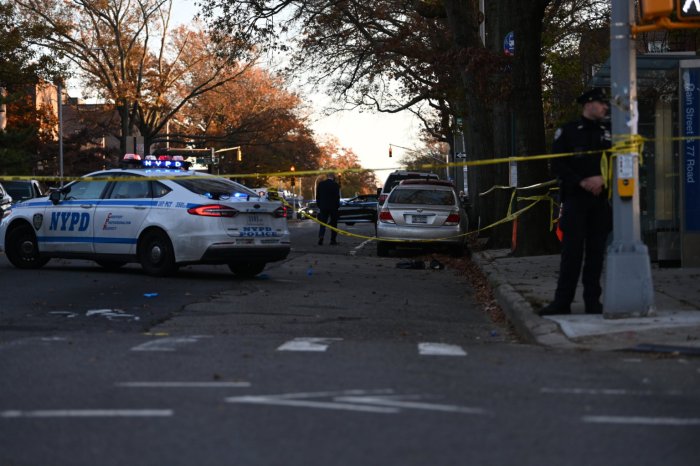Program Aims To Reduce Addiction & Abuse
Mayor Michael R. Bloomberg, Deputy Mayor for Health and Human Services Linda I. Gibbs and Chief Policy Advisor John Feinblatt came to Elmhurst last Thursday, Jan. 10, to release the initial report of the Mayor’s Task Force on Prescription Painkiller Abuse, which includes new voluntary emergency room guidelines for the prescription of certain types of painkillers to prevent abuse.

The guidelines, which will be used in all of the city’s public hospitals, state that the emergency departments will not prescribe long-acting opioid painkillers; can only prescribe up to a three-day supply of opioids; and will not refill lost, stolen or destroyed prescriptions.
Between 2004 and 2010, the rate of opioid painkiller-related emergency department visits nearly tripled in New York City, rising from 55 visits for every 100,000 people to 143 and the guidelines are designed to reduce prescription abuse and overdose by encouraging judicious prescribing, patient education, referral to primary care and treatment for substance abuse when needed.
The guidelines are also designed to prevent an excess supply of opioid painkillers. Reportedly, three out of four people abusing painkillers obtain them from leftover medications.
Opioid painkillers include oxycodone (e.g. OxyContin, Roxicodone), hydrocodone (e.g. Vicodin), morphine, fentanyl patches and methadone. In recent years, there has been an increase in the number of New Yorkers reporting misuse of these drugs and in overdose deaths involving opioid medication: Between 2002-2003 and 2008-2009 (the latest data available), self-reported, non-prescription opioid use increased by 40 percent, with 263,000 New Yorkers (four percent of the population) aged 12 and older reporting misuse in 2008-2009.
In addition to the prescribing guidelines, the Task Force report led to the creation of NYC RxStat, which will for the first time combine and use relevant public health and public safety data to combat the problem of prescription painkiller abuse. The Task Force has worked to raise awareness of painkiller abuse through public education campaigns and has worked with the State to create an improved Prescription Drug Monitoring Program.
The mayor made the announcement at Elmhurst Hospital Center, where he was joined by Staten Island District Attorney Daniel Donovan, Special Narcotics Prosecutor Bridget Brennan, Health and Hospitals Corporation Chief Medical Officer Ross Wilson, Senior Health Advisor Andrea Cohen, Dr. Lewis Nelson, Professor of Emergency Medicine at the New York University School of Medicine, and Dr. Stu Kessler, head of Elmhurst Hospital Emergency Department.
“Prescription painkillers can provide life-changing relief for people in dire health situations, but they can be extremely dangerous if used or prescribed improperly,” said Bloomberg. “Working with health care providers and public health criminal justice experts our task force is providing the tools to fight a burgeoning epidemic while protecting legitimate health care needs. Together we are committed to addressing the violent impact that drug abuse is having on individuals and communities.”
“Prescription opioid painkillers can be just as dangerous as illegal drugs,” added Farley. “These new guidelines will help reduce prescription drug misuse while also making sure that patients coming to emergency departments have access to safe and appropriate pain relief options.”
“These guidelines will help emergency department physicians strike a balance between easing a patient’s pain and discomfort while helping to ensure that medications that can be abused are not over prescribed,” said Kessler, who also serves on the board of directors of the New York State Chapter of the American College of Emergency Physicians.
In 2010, prescription painkillers were involved in 173 unintentional overdose deaths in New York City, a 30 percent increase from 2005.
The new opioid emergency department prescription guidelines, which hospitals can choose to display in emergency departments, clarify that:
– Emergency departments will not prescribe long-acting opioid painkillers such as extended-release oxycodone, fentanyl patches or methadone.
– In most cases, emergency departments will prescribe no more than a three-day supply of opioid painkillers.
– Emergency departments will not refill lost, stolen or destroyed prescriptions.
– The posters also include tips to reduce unintended harms of opioid painkillers. The poster is available in English, Spanish, Chinese and Russian. The 11 emergency departments of the New York City Health and Hospitals
Corporation, which operates all of the city’s public hospitals, have agreed to adopt these guidelines. The Health Department is encouraging private hospitals to adopt these guidelines as well.
Created by the city Health Department, the new voluntary prescription guidelines are endorsed by the Health and Hospitals Corporation and the New York State Chapter of the American College of Emergency Physicians, and were influenced by the City Health Information Bulletin on opioid prescribing, “Preventing Misuse of Prescription Opioid Drugs” and opioid prescribing guidelines practiced in other jurisdictions.
The large increase in people who misuse prescription painkillers has not only led to a significant increase in the number of opioid analgesic-associated emergency room visits, but also a higher number of painkiller-related fatalities. Unlike previous substance abuse epidemics, this epidemic involves substances-opioids-that are legally produced and sold. This makes the drugs easier to obtain, but also makes it easier for law enforcement and public health officials to track the source and usage of painkillers.
With this large amount of data available for analysis, the Task Force, in partnership with NY/NJ HIDTA, created NYC RxStat, which will track relevant public health and public safety data. Participants in RxStat, including representatives from an array of city, state, and federal agencies (including the Drug Enforcement Administration), will meet regularly to share data and conclusions so that the appropriate city response can be targeted where it will be most effective in addressing the crisis.
RxStat members will regularly report on critical indicators that measure the impact of prescription painkiller abuse on the city. In addition to this reporting, RxStat will convene briefings among public health and public safety stakeholders to share strategies and describe trends. This process will provide stakeholders with an up-to-date view of the problem so that they can coordinate efforts and use resources most efficiently and effectively.
By analyzing the data and deploying resources more effectively, Bloomberg noted, the city will be able to keep up with the ever changing patterns of drug abuse.
The full report is the result of a collaborative effort from the 13 members of the Task Force, highlights the work done during the past year, makes recommendations for changes in policy and practice and describes the Task Force’s next steps. It is available at www.nyc.gov.
Anyone who is, or knows someone who has a problem with painkillers should call 1-800-LIFENET.





























